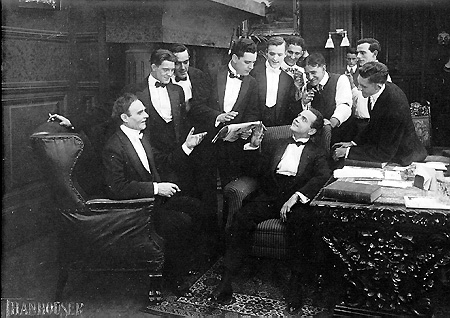 Volume II: Filmography
Volume II: Filmography Volume II: Filmography
Volume II: Filmography

Production still courtesy Dominick Bruzzese. (F-790-2)
September 29, 1914 (Tuesday)
Length: 2 reels (2,003 feet)
Character: "An exciting detective story"
Director: W. Eugene Moore
Scenario: John William Kellette
Cast: Mildred Heller (May Morris, the landlord's daughter), Harry Benham (Jack, United States postal inspector), John Myers (Tom, a crook), Sam Niblack (Joe, Tom's pal), George Niblack, David Keleher
Notes: 1. In some notices the title appeared as The Trail of the Lovelorn. 2. Production of this film took place during the week of August 31, 1914. 3. In the film the crooks played by John Myers and Sam Niblack were known as Williamson & Co.
ARTICLE, The New Rochelle Pioneer, September 5, 1914:
"W. Eugene Moore is producing a two-reel detective postal-service drama this week with Harry Benham and Miss Heller in the leads. It is a story based upon mail fraud order schemes recently rejuvenated by the postal service, and teaches the unwary how to avoid falling into the fraud mail order crooks' net. The one best way to avoid it, however, is to trade at home with home merchants. Its title is Trail of the Lovelorn."
SYNOPSIS, Reel Life, September 26, 1914:
"Tom and Joe, two mail order crooks, are put out of business by Jack, a postal inspector for Uncle Sam. Arriving in a small town, they are attracted by the beauty of May Morris, and manage to secure board and lodging in her father's house. They then steal a photograph of May to use as an advertisement in a matrimonial paper, and thus make some easy money. The scheme works, and in addition to impassioned letters money and jewelry pour in. It happens that Frank, who sends a necklace which is intercepted by the crooks, not hearing from May, complains to Jack. He gets on the case, and through May, with whom he has long been in love, manages to track down the crooks. He also saves the girl from implication in their crime and from the 'third degree.' Soon after, Jack and May are married."
REVIEW, The Bioscope, December 31, 1914:
"When the Thanhouser Company set out to make a really fine film play, there are very few people who can equal their results, and none who can surpass them. The Trail of the Lovelorn is an example of the Thanhouser Company at their best. It is a story dealing with the detection of crime, and it is as skillfully conceived and constructed by the author as it is perfectly presented by producer and players. It is, moreover, that very rare thing, an entirely novel film. The form of crime it illustrates is not the conventional jewel robbery or rich-man-murder of the average film, but is a 'stunt' (as its perpetrators would doubtless term it) so full of ingenious originality as to be full of interest on its own account. Still more interesting, thanks to the magnificent manner in which the film is handled, is the lengthy process by means of which the detective of the play (represented with the utmost plausibility by that very finished actor, Mr. Harry Benham) tracks down and captures the miscreants after numerous failures, one of which involves the arrest of two innocent people, themselves victims of the wily wrongdoers. Although it is quite breathlessly exciting, there is no suggestion of cheap sensational melodrama in the story, which is logically developed throughout in a series of strictly natural episodes. It would be rather unfair to give away the very original idea which forms the basis of this most entertaining film, and we will, therefore, leave our readers to discover for themselves on seeing the picture the enterprising system of dishonesty with which it deals. We cordially recommend the production to all who are in search of a really excellent play, however, and we do not fancy that any exhibitor who books it will be disappointed."
REVIEW, The Moving Picture World, October 10, 1914:
"A two-reel photoplay dealing with the efforts of the postal service officials to round up two get-rich-quick fellows, who are promoting a fake matrimonial agency. The photography is rather uneven and the story, while quite interesting, does not work up very strongly. The most interesting feature was the manner in which the girl photographed one of the crooks while he was asleep, thus leading to his identification later. The capture of the crooks lacked the suspense it should have, and the suggestive love affair at the last seemed absurd, as the young official had scarcely noticed the girl before."
# # #
Copyright © 1995 Q. David Bowers. All Rights Reserved.